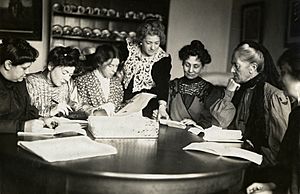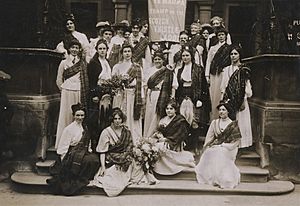Flora Drummond facts for kids
Quick facts for kids
Flora Drummond
|
|
|---|---|

Flora Drummond in her Generals' uniform and WSPU sash
|
|
| Born |
Flora McKinnon Gibson
4 August 1878 Manchester, England
|
| Died | 17 January 1949 (aged 70) Carradale, Argyll, Scotland
|
| Nationality | British |
| Other names | "The General" |
| Known for | Daring Stunts |
Flora McKinnon Drummond (born 4 August 1878, Manchester – died 17 January 1949, Carradale) was a British suffragette. She was given the nickname 'The General'. This was because she often led marches for women's rights. She wore a military-style uniform with an officer's cap and rode a large horse.
Flora Drummond was a key organizer for the Women's Social and Political Union (WSPU). This group fought for women's right to vote. She was put in prison nine times for her actions in the women's suffrage movement. Drummond was very good at organizing and leading rallies, marches, and protests. She was also a skilled speaker. She was known for being able to handle people who tried to interrupt her speeches.
Contents
Early Life and Challenges
Flora McKinnon Gibson was born on August 4, 1878, in Manchester, England. Her parents were Sarah and Francis Gibson. Her father was a tailor. When Flora was young, her family moved to Pirnmill on the Isle of Arran, where her mother's family lived.
After finishing high school at age fourteen, Flora moved to Glasgow. She took a business course to become a post-mistress. She passed the tests, but she was too short. The new rule said post-mistresses had to be at least 5 feet 2 inches tall. Flora was 5 feet 1 inch. This unfair rule made her feel angry about how women were treated.
Later, she learned shorthand and typing. She married Joseph Drummond and moved back to Manchester. She became a manager at a typewriter factory. She and her husband were interested in politics and workers' rights.
Fighting for Women's Vote

Flora Drummond joined the WSPU in 1906. The WSPU was a group that used strong actions to get women the right to vote. She decided to join after seeing Christabel Pankhurst and Annie Kenney arrested. They were asking a politician, Winston Churchill, about women's voting rights.
Soon after, Flora moved to London. By the end of 1906, she was arrested for the first time. She had entered the House of Commons building. Flora became known for her bold and attention-grabbing actions. In 1906, she even slipped into 10 Downing Street, the Prime Minister's home. This happened while her friend was being arrested outside.
In 1908, Flora became a paid organizer for the WSPU. She even rented a boat to protest near the Palace of Westminster from the River Thames. She shouted at members of parliament from the river.
Scottish Suffragettes and Protests
Flora Drummond often welcomed suffragettes released from prison. When Mary Phillips was freed, Flora greeted her with bagpipes. Other suffragettes wore tartan sashes for a photo. Their slogan was "Ye Mauna Tramp on the Scotch Thistle Laddie." This compared their fight to the Scottish hero William Wallace.
In October 1908, Flora organized a large rally in Trafalgar Square. This led to her being imprisoned for three months. She was jailed with Christabel Pankhurst and Emmeline Pankhurst. They were accused of encouraging people to rush the House of Commons. Flora was pregnant at the time. She became ill in prison and was released early. Emmeline Pankhurst told her to "carry on the work" as she left.
Flora Drummond received a special medal from the WSPU called the "Hunger Strike Medal 'for Valour'". This was for her bravery after being imprisoned nine times and going on hunger strikes.
In October 1909, Flora organized the first big protest march in Edinburgh. The march showed that Scottish women were ready to fight for their rights. Women carried banners and played bagpipes. They dressed in their work clothes or as famous Scottish women from history. Thousands of people watched the parade. It was a great success.
Meeting with Politicians
In 1913, Flora Drummond and Annie Kenney arranged for working-class women to meet with important politicians. These included David Lloyd George and Sir Edward Grey. The women explained their low pay and poor working conditions. They hoped that getting the right to vote would help them change things fairly. Alice Hawkins explained how men could choose their leaders, but women could not.
Flora also led the WSPU Cycling Scouts. These women rode bicycles from London to the countryside. They spread the message about women's right to vote.
In May 1914, Flora Drummond and Norah Dacre Fox protested at the homes of two politicians, Lord Carson and Lord Lansdowne. These politicians were encouraging protests in Ireland. Flora and Norah were arrested for making speeches that encouraged women to take strong action. They said they should be safe like the lords who were also encouraging protests. They were sent to prison and went on hunger and thirst strikes.
Later Life and Recognition
Being in prison many times, and going on hunger strikes, took a toll on Flora's health. In 1914, she went to the Isle of Arran to get better. When World War I started, she focused on public speaking and organizing instead of direct protests. This helped her avoid more arrests.
During the war, Flora supported the government. In 1915, she asked for volunteers in Trafalgar Square. She said, "We have given up our fight for the vote...today is the time for sacrifices." In 1917, she reviewed female war workers in Birkenhead with David Lloyd George.
Flora remained an important figure. In 1928, she helped carry the coffin at the funeral of Emmeline Pankhurst.
Later in her life, Flora's political views changed. She encouraged workers not to strike. In 1926, she led a march called the Great Prosperity March. This march was against the unrest before the General Strike. In the 1930s, she formed the Women's Guild of Empire. This group was against certain political ideas.
Flora and Joseph Drummond divorced in 1922. Later that year, she married her cousin, Alan Simpson. Alan was killed during an air-raid in 1944. A few years before, Flora had written articles about her life called 'My campaigning days'.
Flora returned to Arran. She was not allowed to build a cottage. So, she lived in a small shed with a corrugated iron roof. When she became ill, her neighbors took her in. She died in 1949 at age 70 after a stroke.
Posthumous Recognition
In 2001, a headstone was placed on Flora Drummond's grave in Kintyre. It honored her as the 'Suffragette General'.
Her name and picture are also on the plinth of the statue of Millicent Fawcett in Parliament Square, London. This statue was unveiled in 2018. It honors many women who fought for women's right to vote.
See also
 In Spanish: Flora Drummond para niños
In Spanish: Flora Drummond para niños


